Change log
Updates for Ver3.4.0
New Features
Group Delay
Group delay calculation is now supported.
In the calculation of group delay, differentiation also includes the optical constants (the dispersion formulas of n and k).
Numerical differentiation (finite difference) with large errors is not used.
| Supported Types of Group Delay | |
|---|---|
| GD | Group Delay |
| GDD | Group Delay Dispersion |
| CDC | Chromatic Dispersion Coefficient |
| TOD | Third Order Dispersion |
| FOD | Fourth Order Dispersion |
| 5OD | Fifth Order Dispersion |
| Units |
|---|
| ps, fs |
Improvements
Phase
The phase display range can now be selected as either 0° to 360° or -180° to 180°.
Select this option in [Tools]-[Options]-[Phase and Group Delay].
Spectrophotometer Data File Import
Added support for importing UDSS files from Hitachi's new spectrophotometer software, UV-Solutions Plus (also supports .txt files).
Numerical Data
Spectrophotometer data and user line data are now displayed in the numerical data view.
(Displays values linearly interpolated based on the calculation range and interval.)
The average value for Phase (angle) in Numerical Data is now calculated using the vector sum.
Dispersion Data Graph
The dispersion data graph now reflects dn and dk values.
You can toggle their display on or off from the graph toolbar.
Optimization
Windows sleep is now prevented during optimization.
Improved Calculation Accuracy for Substrates and Stack Media with Absorption Coefficient (k)
The calculation method for back side characteristics and Stack calculations has been changed to one that does not use the angle of refraction.
The method for calculating the incident angle from the back side has been changed to use the wave vector instead of the complex angle of refraction (used only for graph display).
Stack
You can now select the calculation method for cases where the Substrate or Medium within a Stack has an absorption coefficient (k).
Select this option in [Tools]-[Options]-[Stack].
Evaporation Control
The attenuation calculation for the Substrate has been changed to use internal transmittance (Ti) instead of the absorption coefficient (k).
Miscellaneous
Added keyboard shortcuts for menu commands and other items.
Bug fixes
Fixed an issue where optimization of transmission phase was not possible
Fixed an issue in the n and k analysis of monolayer film where an error occurred if the start of the analysis range for 'n' was set near 0.
Fixed other minor issues.
Latest version download (customers only)
Updates for Ver3.3.7
Bug fixes
Fixed a bug that could cause errors in global search and needle search during optimization.
Fixed an issue where errors occurred during optimization due to insufficient memory when the number of target data points was extremely large.
Fixed a bug that prevented the selection of a series in the incidence angle chart in freehand mode during optimization.
Fixed a bug that prevented the switching of the calculation method for phase difference (dFr, dFt) ([Options]-[Other]) from working.
Updates for Ver3.3.6
Bug fixes
Fixed a bug where [n and k analysis] - [Calculate refractive index of substrate without absorption] could not calculate the double-sided reflectance or transmittance when the incidence was oblique.
Updates for Ver3.3.5
Bug fixes
Fixed a bug where an error would occur when there was no film in the stack during needle search.
Updates for Ver3.3.4
Bug fixes
Fixed a bug where an error would occur when adding Material on the needle search parameter screen.
Fixed a bug where an error would occur if there was an extremely thick absorption film.
Improvement
Improved calculation speed.
The needle search algorithm has been slightly changed.
Updates for Ver3.3.3 Demo
Bug fixes
Fixed a bug where an error occurred when the angle of incidence was 45 degrees or more.
Updates for Ver3.3.2
Bug fixes
Fixed a bug where an error occurred if the period or magnification of the periodic layer was changed while the stack window was displayed.
Fixed a bug where an error occurred when the period of the periodic layer was extremely large (about several thousand).
Updates for Ver3.3.1
Bug fixes
Fixed a bug that caused an error when selecting inhomogeneity in nk analysis of mono layer film.
Fixed a bug where the home position of the film thickness change slide bar would change when you press the apply button on the main window.
The display characters have been slightly modified.
Updates for Ver3.3.0
Spectrum types and units
The following spectrum types and units are now supported.
| Spectrum types | Units |
|---|---|
| Wavelength | Å, nm, μm, mm |
| Frequency | PHz, THz, GHz |
| Wave number | cm-1, μm-1, 2π/cm |
| Angular frequency | rad/fs |
| Energy | eV, keV |
| g-Number | λ/λ0 |
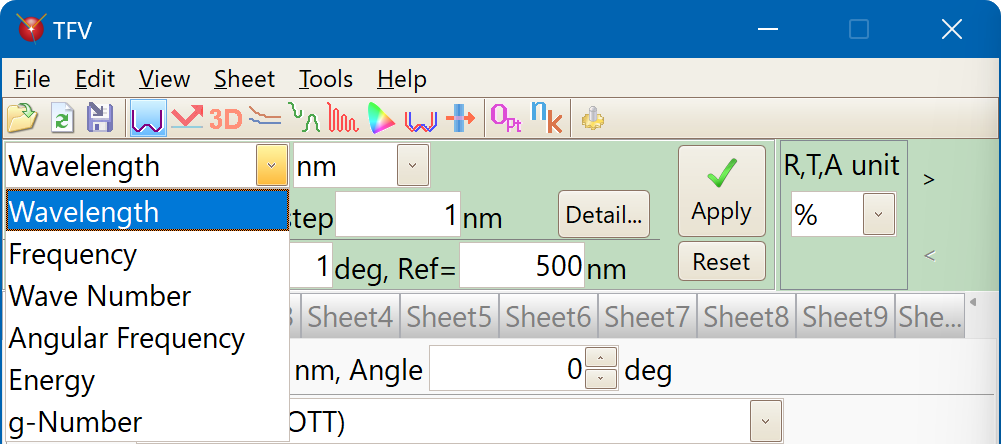
R, T, A units
You can now select units for reflectance(R), transmittance(T), and absorption(A).
| Units for reflectance, transmittance, and absorption |
|---|
| 0-1, %, dB |
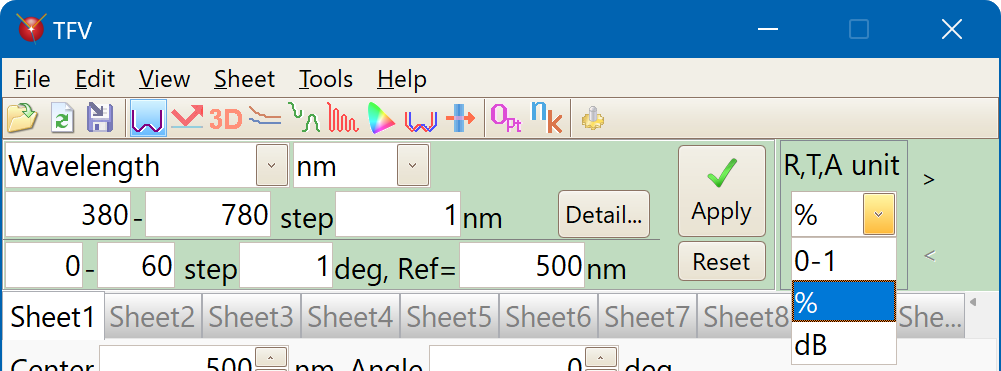
Optical density
Added support for optical density (OD) calculation.

Units of film thickness
Added μm and mm to the physical film thickness units.
| Film thickness types | Units |
|---|---|
| Physical thickness | Å, nm, μm, mm |
| Optical thickness | FWOT, QWOT |
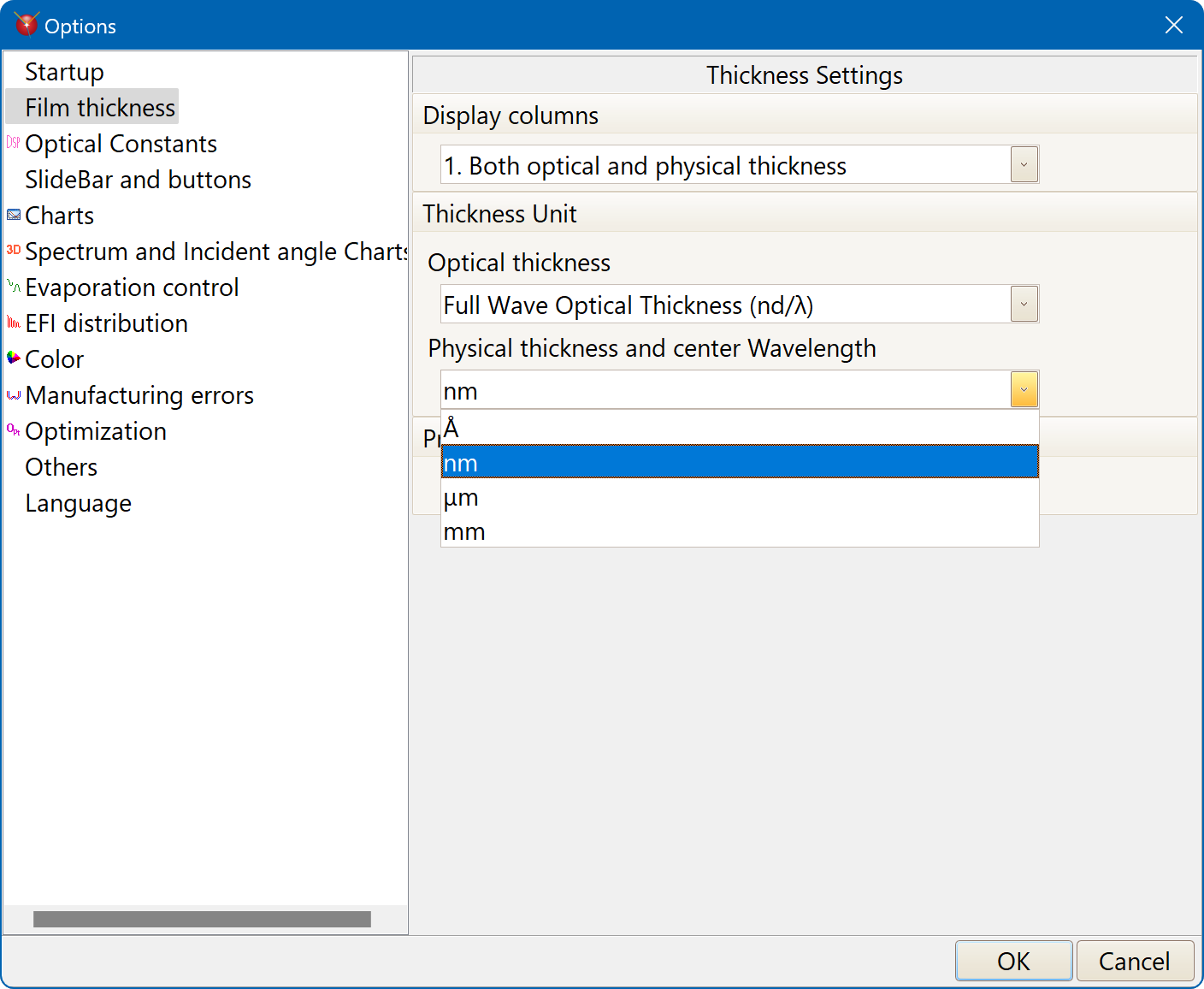
Bug fixes
Fixed an issue where an error would occur in regions where a decimal separator other than a period was used.
Fixed a bug where input after the second decimal place was not reflected due to the thickness of the substrate or medium in the stack.
Fixed a bug where an error would occur when the number of layers was large (about several thousand layers).
Fixed other minor bugs.
Functional improvements and specification changes
The "Deviation" in the optimization results has been changed to "Merit (merit function)".
\(Merit = \sqrt{ {1 \over N} \sum_{i=1}^{N}(T_i-T'_i)^2 } \)
N: Number of target, Ti: Calculated value, T'i: Target value
\(Merit = Deviation / \sqrt{ N } \)
This is disabled by default to prevent incorrect operations.
[Tools] - [Options] - [Others] - Check "Enable change value with mouse wheel" to use it.
Updates for Ver3.2.7
Fixed a bug that the result was not displayed correctly when setting the same film data or no film multiple times in stack optimization.
Updates for Ver3.2.6
Improved fitting performance for n and k analysis of substrate and monolayer film.
Updates for Ver3.2.5
Fixed a bug that Ctrl + C, Ctrl + V copy and paste did not work in cells of the main window for Ver3.2.4.
Updates for Ver3.2.4
Fixed a bug that caused an error in the optimization target when the Input type: Continuous(IncidentAngle).
Fixed a bug that the layout of the user line window gradually shifts.
Supports Olympus USPM-RU-W CSV files by reading spectrophotometer files.
Updates for Ver3.2.1
Fixed a bug where the xy value was plotted when the a*b* chromaticity diagram was selected in the manufacturing error analysis graph.
Fixed a bug that an error occurs when Ra, Rp… on the stack screen is unchecked in the color calculation.
What's new in Ver3.2
n and k calculation for substrate and film
It is now possible to calculate the nk of substrates and metal films.
The following 4 types of calculations can be performed.
- Calculate refractive index of substrate without absorption
Calculate the refractive index of a substrate without films. It is used when there is no absorption on the substrate. A single-sided matte substrate or double-sided polished substrate is required. - Calculate refractive index, absorption coefficient and internal transmittance of substrate
Calculate the refractive index of a substrate without films. It is used when substrate has absorption. Both single-sided matte substrate and double-sided polished substrate are required. - n and k analysis of monolayer film
From the spectral reflectance and spectral transmittance, n, k and film thickness (d) of the film are analyzed by curve fitting to the dispersion formula.
Added an option to analyze only normal dispersion (dispersion in which the refractive index increases as the wavelength becomes shorter).
It is now possible to calculate each measurement data of "front reflection", "back reflection", and "transmission" even with different wavelengths and different measurement points. - Calculate n and k of monolayer metal film
Calculate n and k of the metal film from the front surface reflectance and the back-surface reflectance. The substrate must be thick enough and have a zero transmittance.
Dispersion formula
Two types of dispersion formula have been added.
-
SellmeierX1
\[n(λ) = \sqrt{ 1 + {A_0λ^2 \over λ^2-{A_3}^2} + {A_1λ^2 \over λ^2-{A_4}^2} + {A_2λ^2 \over λ^2-{A_5}^2} } \] -
Forouhi-Bloomer
\[n(E) = n(∞) + {B_0E+C_0 \over E^2 - BE + C} \] \[k(E) = {A(E-E_g)^2 \over {E^2 - BE + C}} \] \[B_0 = {A \over Q}{({-B^2 \over 2} + E_gB - {E_g}^2 + C)} \] \[C_0 = {A \over Q}{\left(({E_g}^2 + C){B \over 2}-2E_gC\right)} \] \[Q = {1 \over 2}{(4C-B^2)}^{1 \over 2} \] \[E= {{hc} \over λ} \]h: Planck's constant, c: Light speed, The unit of E: eV.
n(∞), Eg, A, B, C: Material constants(parameters of the dispersion formula)
Manufacturing errors analysis
When the graph type or the type such as Ra, Rs, Rp, Ta ... is switched, the same random number is used and the calculation is automatically performed.
If you want to use different random numbers, press the execute button.
In addition, it is now possible to analyze manufacturing errors for stack. When the stack window is displayed, the manufacturing error for stack is calculated. When the stack window is closed, the manufacturing error on one side (of the main window) is calculated.
Optimize
You can now target the mean if the target type is continuous.
The figure below is an example in which the average value of Ra from wavelength 500 nm to 600 nm is targeted at 50%.
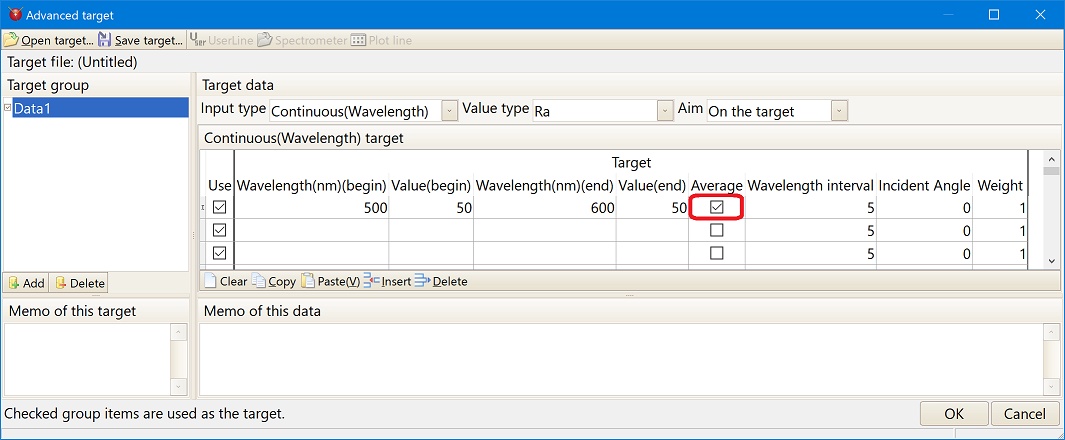
Import ZEMAX glass data File
You can import the glass data (AGF file) of the optical design software ZEMAX.
From the main window menu, select [File] - [Import] - [Import Zemax OpticStudio glass catalog (AGF file)…].
Glass data update
The glass data has been updated to the latest version.
SCHOTT: January 2019
OHARA: August 3, 2020
HOYA: March 14, 2020
HIKARI: April 1, 2020
SUMITA: July 15, 2020
CDGM: September 2020
Design data sample
Added samples of design data.
Bug fixes
The stability of operation has been improved by reducing the amount of memory used.
Solved the problem that it was difficult to enter the decimal point in the center wavelength and incident angle fields.
Fixed the problem that the evaporation control may not respond for a long time when inputting the filter wavelength.
Other minor bug fixes.
Specification change
In the color calculation, the aspect ratio of the chromaticity diagram is fixed.
If you want to use the conventional display method, go to [Chart format]-[Options] and uncheck "Fix chart aspect ratio".
All window positions are now memorized by selecting [Tools]-[Save window position] from the main window menu.
What's new in Ver3.1
Color calculation
The color matching function has been updated to conform to ISO 11664-1: 2007.
Compared to the previous version of the color matching function ISO 10526: 1991, the calculation result is slightly different because the number of digits after the decimal point is increased.
User-created color matching functions can now be used.
Color calculation method can be selected from "360-830nm, 1nm interval", "380-780nm, 1nm interval", "380-780nm, 5nm interval (default)".
Set in [Tools]-[Options]-[Color]-[Calculation range and step].
* Normally, calculations at 5nm intervals are sufficient.
Added z to the numerical value of chromaticity coordinates of XYZ color system.
Added Dominant Wavelength (λd), Complementary Wavelength (λc), Excitation Purity (Pe), and Colorimetric Purity (Pc).
Dispersion formula
Added Cauchy to dispersion formula of k.
Importing Essential Macleod data
Added the function to import Essential Macleod Material and Substrate.
The import screen is displayed by selecting [File]-[Import] from the menu.
Essential Macleod design data (dds file) can be read.
From the menu, open the dds file with [File]-[Open].
The center wavelength, incident angle, substrate, incident medium, number of layers, film thickness/material of each layer, and notes are loaded.
If a substrate/material with the same name does not exist in TFV, the substrate/material will be imported automatically.
* Please note that the calculation results will be different if Essential Macleod and TFV have the same substrate/material with different dispersion data.
Export to optical design software ZEMAX
Added the function to export design values or calculation results to ZEMAX coating files.
From the menu, select [File]-[Export] to display the export screen.
Bug fixes
Fixed a bug that the initial light source at startup could not be selected with [Tool]-[Option]-[Color].
Fixed a bug that the needle search doesn't work when the first side of the stack has no film.
Other minor bug fixes and improvements.
What's new in Ver3.0
Film thickness display format
Both optical film thickness and physical film thickness are now displayed.
The unit of physical thickness can be selected in nm and Å.
The unit of optical thickness can be selected in nd/λ(FWOT) or QWOT.
Number of sheets
The number of sheets in the main window has increased to 20.
Optimization
You can now optimize colors and stacks.
It now displays optimization history at needle search.
Manufacturing error
You can now set the amount of change for each layer.
It is now possible to calculate when changing randomly with normal (Gaussian) distribution.
n and k analysis
Analysis wavelength range can now be set.
There were cases where analysis could not be done in the previous version, but we improved it so that it can be analyzed as much as possible.
High resolution display compatible 4K ready!
Even characters with high resolution display are now displayed without blurring. Characters are scaled according to the Windows scaling setting.
You can also set font and font size.
Total of multiple substrates (Stack)
It is now possible to calculate multiple substrates.
With the medium to medium as one block, spectral characteristics for each block can be displayed numerically.
You can now register the internal transmittance of the substrate.
Project file
You can save the design data displayed on each sheet of the main window, the structure of the stack window, the arrangement of the window being displayed, the format of the graph, the user line, etc. as a "project" in the file.
Design data editing
You can copy-pasting of design data by selecting the cells.
You can now insert and delete layers multiple layers at once.
Addition of material data
Add the material of the Kyoto Thin-Film Materials Institute.
Al2O3(KTM), HfO2(KTM), LaF3(KTM), Ti3O5(KTM), ZrO2(KTM), ZRT2(KTM)
Many other features have been added.
New Features Manual for Version 3.0(pdf)
Bugfixes and improved in version 3.0.2 to 3.0.4
Fixed the bug that only the first wavelength range is valid when multiple wavelength ranges are set, and the error occurs when reading a project file.
In the manufacturing error analysis, the problem that an error occurs when all units of ΔT, Δn, Δk are set to σ: standard deviation has been corrected.
When ΔT is increased in manufacturing error analysis, the film thickness is improved to be calculated as 0 when the film thickness is negative.
Improved so that Y-axis title and character of Y-axis scale do not overlap in wavelength graph and incident angle graph.
Bugfixes and improved in version 3.0.1 to 3.0.2
Stack
Fixed a bug that is not calculated correctly when the same Sheet design is specified to multiple faces.
Fixed a bug that caused errors in 3D graphs and color calculations.
Others
Fine-tuning in the high resolution display environments.
What's new in Ver2.2
Optimize design
- Automatically initial film design mode has been included in needle search.
- [Optimize design] - [Needle Search] - [Start] - [Needle Search Parameters] - [Automatically initial design]
- The "continue" function of needle search has been improved
- The target value input method was improved. For example, You can input target value to xx% from xx nm to xx nm.
- [Optimize design] - [Advanced target] - [Type] - [Continuous(Wavelength), Continuous(Angle)]
n and k analysis from mono layer
- Inhomogeneity of n and k analyze mode has been included.
- [n and k analysis from mono layer] - [Step4: Analyzing parameters] - [Analyze inhomogeneity of n, k]
Bug fixes
Fixed minor bugs.
What's new in Ver2.1
Add dispersion data
Dispersion data of resin was added.
- Substrate
- PCHMA, PEI, PMMA, Polycarbonate, Polystyrene, SAN
- Film material
- Cytop
Add dispersion formulas
The number of distributed types has been increased to all 28. All ZEMAX distributed expressions can be used.
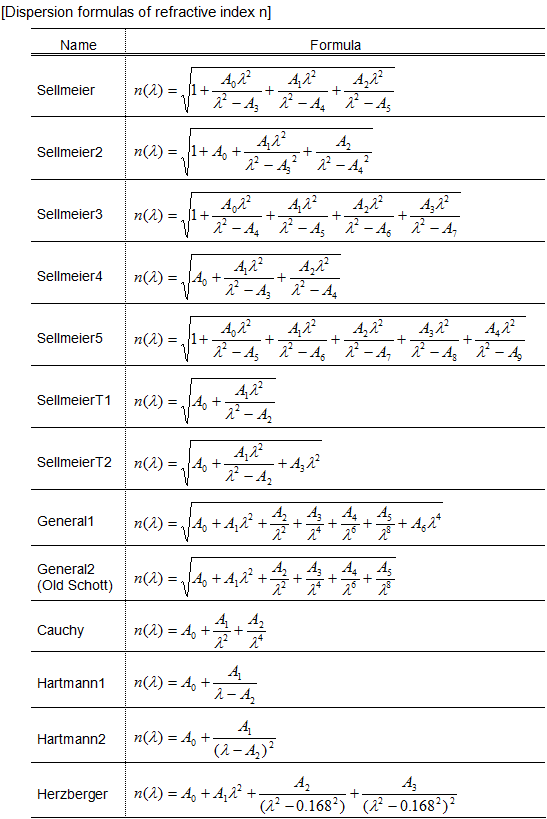
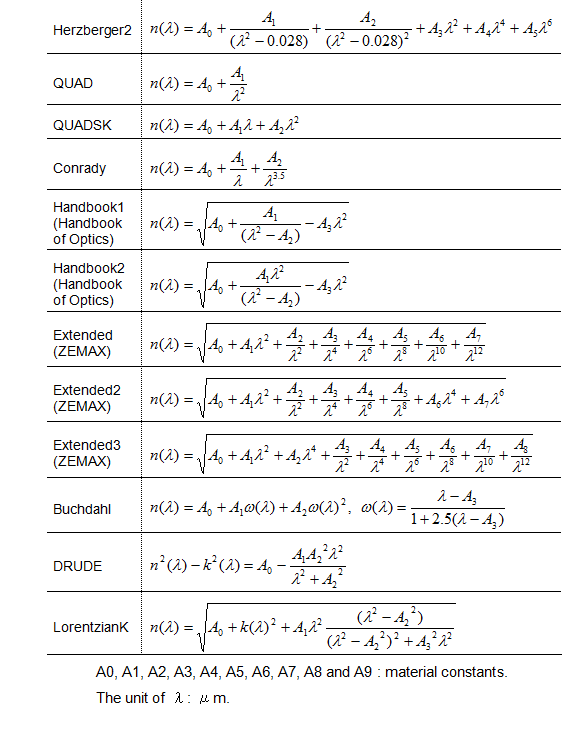
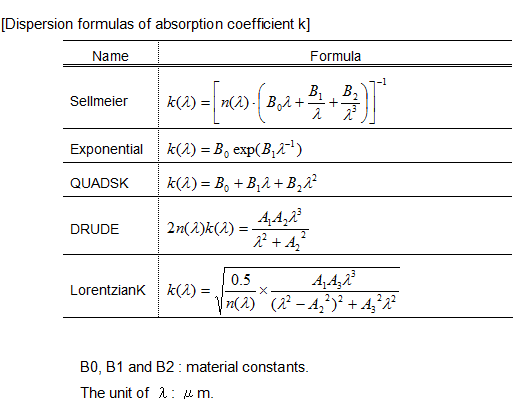
Bug fixes
Fixed minor bugs.
- Bug fix in demo version
- The results of n and k analysis is now shown on the chart.
What's new in Ver2.0
Optimization
It is now possible to optimize wavelength characteristics or angle characteristics.
- (1) Local search
- Local search is used Levenberg-Marquardt Method for optimization thickness.
- (2) Global search
- Global search is used Simulated Annealing Method and Levenberg-Marquardt Method.
- (3) Needle search
- Needle search works by adding the needle-like layers into the design. After the needle-like layers have been added, the local search is used to optimization.
- Free-hand mode
- When you trace with the mouse while holding down the left button near the selected series, then the shape of series is deformed. Optimize will be started automatically when you release the left button.
Wavelength and incident angle 3D chart
You can set the custom contour.
Manufacturing error
You can use Mote Carlo simulation on the wavelength, incident angle and color chart.
n and k analysis from the mono layer measured data
You can analysis n and k from the mono layer measured data.
Inhomogeneity
You can set the inhomogeneity of n and k each layers.
Reverse side
Reverse side characteristics when the same light path from the front side can be shown on the chart simultaneously.
Both side total
The both side total on the parallel plano-substrate can be displayed.
Spectrometer data
It became possible to read the spectrophotometer measured data file directly and show on the wavelength plot chart. Relative measurement value can be converted to absolute value.
Periodic layer enhancement
The magnification of the thickness has been added in periodic layer.
Optical monitor enhancement
The functions of evaporation control have been improved. You can select the monitoring system from the back side reflection, the front side reflection and the transmission.
Electric field enhancement
The polarizations component of the electric field intensity can be selected in the chart window.
Color calculation enhancement
Add the kind of illuminant.
A, B, C, D50, D55, D65, D75, E, F1, F2, F3, F4, F5, F6, F7, F8, F9, F10, F11, F12, ID50, ID65.
Add color difference.
CIE2000.
Others
Add the Chinese-Traditional language.
Glass data updated to the latest version. Add the SUMITA and HIKARI. Total 866 kind of glass data built-in.
The quotation origin of all materials was described.
Add the converting the optical thickness and physical thickness.
Add the changing the center wavelength.
Add the Inversing the layers.
etc.
Bug fixes
Calculation mistake of the stop value in evaporation control when the thickness is optical thickness and the Evp-dn is not zero was fixed.
Color difference calculation mistake of dH* and dE94 were fixed. The sign of dL* and dC* were fixed.
Calculation mistake of the electric field intensity in p-polarization was fixed.